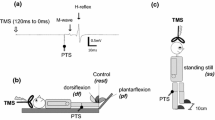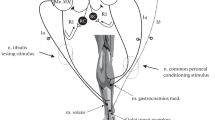Summary
Peripheral and supraspinal loops activated by electrical stimulation of the tibial nerve were studied in alert monkeys. Weak conditioning stimuli below the threshold for muscle contraction and strong conditioning stimuli which elicited a direct motor response and an H-reflex were applied to the tibial nerve, while soleus EMG was recorded. The motoneuronal excitability was measured with a test H-reflex for different intervals between conditioning and test stimuli.
A facilitation of the motoneuronal pool occurred with a latency of about 50 ms for weak, as well as strong, conditioning stimuli. The facilitation was superimposed on a long-lasting inhibition which was more pronounced when strong stimuli were used.
The shape of the excitability curve of the motoneurons after strong conditioning stimuli was studied before and after various lesions. The shape of the curve did not change after an ipsilateral cerebellectomy except that the facilitation was more pronounced. A few days after pyramidotomy, the facilitation diminished in size but it recovered to its initial size after 3 months. Spinal hemisection did not abolish the facilitation. We concluded from these results that a peripheral loop was activated when conditioning stimuli above the threshold for a direct motor and reflex response were applied. The facilitation might be mediated by the muscle contraction and following activation of muscle afferents. Superimposed on this loop is a previously demonstrated transcortical loop of similar latency.
Similar content being viewed by others
References
Allen GI, Tsukahara N (1974) Cerebrocerebellar communication systems. Physiol Rev 54: 957–1006
Aoki M, Mori S, Fujimori B (1976) Exaggeration of knee-jerk following spinal hemisection in monkeys. Brain Res 107: 471–485
Appelberg B (1962) The effect of electrical stimulation of nucleus ruber on the gamma motor system. Acta Physiol Scand 55: 150–159
Appelberg B, Kosary IZ (1963) Excitation of flexor fusimotor neurons by electrical stimulation in the red nucleus. Acta Physiol Scand 59: 445–453
Chan CWY, Melvill Jones G, Kearney RE, Watt DGD (1979) The “late” electromyographic response to limb displacement in man. I. Evidence for supraspinal contribution. Electroencephalogr Clin Neurophysiol 46: 173–181
Chofflon M, Lachat JM, Rüegg DG (1982) A transcortical loop demonstrated by low-threshold muscle afferents in the awake monkey. J Physiol (Lond) 323: 393–402
Diamantopoulos E, Olsen PZ (1967) Excitability of motor neurons in spinal shock in man. J Neurol Neurosurg Psychiatry 30: 427–431
Eklund G, Hagbarth KE, Hägglund JV, Wallin EU (1982a) Mechanical oscillations contributing to the segmentation of the reflex electromyogram response to stretching human muscles. J Physiol (Lond) 326: 65–77
Eklund G, Hagbarth KE, Hägglund JV, Wallin EU (1982b) The “late” reflex responses to muscle stretch: The “resonance hypothesis” versus the “long-loop hypothesis”. J Physiol (Lond) 326: 79–90
Feliux D, Wiesendanger M (1971) Pyramidal and non-pyramidal motor cortical effects on distal forelimb muscles of monkeys. Exp Brain Res 12: 81–91
Gilman S (1969) The mechanism of cerebellar hypotonia. An experimental study in the monkey. Brain 92: 621–638
Ghez C, Shinoda Y (1978) Spinal mechanisms of the functional stretch reflex. Exp Brain Res 32: 55–68
Hagbarth KE, Vallbo AB (1968) Discharge characteristics of human muscle afferents during muscle stretch and contraction. Exp Neurol 22: 674–694
Hagbarth KE, Hägglund JU, Wallin EU, Young RR (1981) Grouped spindle and electromyographic responses to abrupt wrist extension in movements in man. J Physiol (Lond) 312: 81–96
Hoffmann P (1934) Die physiologischen Eigenschaften der Eigenreflexe. Ergeb Physiol Biol Chem Exp Pharmakol 36: 15–108
Iles JF (1977) Responses in human pretibial muscles to sudden stretch and to nerve stimulation. Exp Brain Res 30: 451–470
Lacour M, Roll JP, Appaix M (1976) Modifications and development of spinal reflexes in the alert baboon (Papio papio) following an unilateral vestibular neurotomy. Brain Res 113: 255–269
Lee RG, Tatton WG (1975) Motor responses to sudden limb displacements in primates with specific CNS lesions and in human patients with motor system disorders. Can J Neurol Sci 2: 285–293
Liberson WT, Paillard J (1963) H- and T-reflexes in spinal cord injury patients — a preliminary report. Proc 12th Ann Clin Spinal Cord Injury Conf, pp 47–55
Magladery JW (1955) Some observations on spinal reflexes in man. Pflügers Arch 261: 302–321
Marsden CD, Merton PA, Morton HB (1976) Stretch reflex and servo action in a variety of human muscles. J Physiol (Lond) 259: 531–560
Marsden CD, Merton PA, Morton HB, Adam J (1977a) The effect of posterior column lesions on servo responses from the human long thumb flexor. Brain 100: 185–200
Marsden CD, Merton PA, Morton HB, Adam J (1977b) The effect of lesions of the sensorimotor cortex and the capsular pathways on servo responses from the human long thumb flexor. Brain 100: 503–526
Massion J (1967) The mammalian red nucleus. Physiol Rev 47: 383–436
Meinck HM (1980) Facilitation and inhibition of the human Hreflex as a function of the amplitude of the control reflex. Electroencephalogr Clin Neurophysiol 48: 203–211
Miller AD, Brooks VB (1981) Late muscular responses to arm perturbations persist during supraspinal disfunctions in monkeys. Exp Brain Res 41: 146–158
Paillard J (1955) Analyse électrophysiologique et comparaison, chez l'homme, du réflexe de Hoffmann et du réflexe myotatique. Pflügers Arch 260: 448–479
Rüegg DG, Lachat JM, Wiesendanger M (1977) Transcortical facilitation of the H-(monosynaptic) reflex in monkeys. Soc Neurosci Abstr 3: 277
Szumski AJ, Burg D, Struppler A, Vehlo F (1974) Activity of muscle spindles during muscle twitch and clonus in normal and spastic human subjects. Electroencephalogr Clin Neurophysiol 37: 589–597
Táboříková H, Sax DS (1969) Conditioning H-reflexes by a preceding subthreshold H-reflex stimulus. Brain 92: 203–212
Tatton WG, Forner SD, Gerstein GL, Chambes WW, Liu CN (1975) The effect of postcentral cortical lesions on motor responses to sudden upper limb displacements in monkeys. Brain Res 96: 108–113
Teasdall RD, Magladery JW, Ramey EH (1958) Changes in reflex patterns following spinal cord hemisection in cats. Bull Johns Hopkins Hosp 103: 223–235
Tracey DJ, Walmsley B, Brinkman J (1980) “Long-loop” reflexes can be obtained in spinal monkeys. Neurosci Lett 18: 59–65
Vilis T, Cooke JD (1976) Modulation of the functional stretch reflex by the segmental reflex pathway. Exp Brain Res 25: 247–254
Vilis T, Hore J (1977) Effects of changes in mechanical state of limb on cerebellar intention tremor. J Neurophysiol 40: 1214–1224
Wiesendanger M, Miles TS (1982) The ascending pathway of lowthreshold muscle afferents to the cerebral cortex and its possible role in motor control. Physiol Rev 62: 1234–1270
Author information
Authors and Affiliations
Additional information
Supported by the Swiss National Science Foundation (grant no. 3752-1.80)
Rights and permissions
About this article
Cite this article
Rüegg, D.G., Chofflon, M. Peripheral and transcortical loops activated by electrical stimulation of the tibial nerve in the monkey. Exp Brain Res 50, 293–298 (1983). https://doi.org/10.1007/BF00239193
Received:
Issue Date:
DOI: https://doi.org/10.1007/BF00239193




